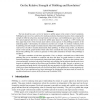Free Online Productivity Tools
i2Speak
i2Symbol
i2OCR
iTex2Img
iWeb2Print
iWeb2Shot
i2Type
iPdf2Split
iPdf2Merge
i2Bopomofo
i2Arabic
i2Style
i2Image
i2PDF
iLatex2Rtf
Sci2ools
COCO
2010
Springer
2010
Springer
On the Relative Strength of Pebbling and Resolution
The last decade has seen a revival of interest in pebble games in the context of proof complexity. Pebbling has proven to be a useful tool for studying resolution-based proof systems when comparing the strength of different subsystems, showing bounds on proof space, and establishing size-space trade-offs. The typical approach has been to encode the pebble game played on a graph as a CNF formula and then argue that proofs of this formula must inherit (various aspects of) the pebbling properties of the underlying graph. Unfortunately, the reductions used here are not tight. To simulate resolution proofs by pebblings, the full strength of nondeterministic black-white pebbling is needed, whereas resolution is only known to be able to simulate deterministic black pebbling. To obtain strong results, one therefore needs to find specific graph families which either have essentially the same properties for black and black-white pebbling (not at all true in general) or which admit simulations...
Algorithms | Black-white Pebbling | COCO 2010 | Nondeterministic Black-white Pebbling | Resolution-based Proof Systems |
| Added | 15 Aug 2010 |
| Updated | 15 Aug 2010 |
| Type | Conference |
| Year | 2010 |
| Where | COCO |
| Authors | Jakob Nordström |
Comments (0)

